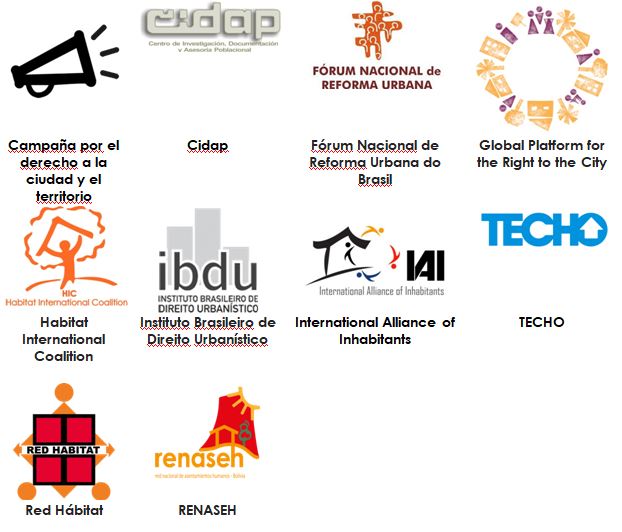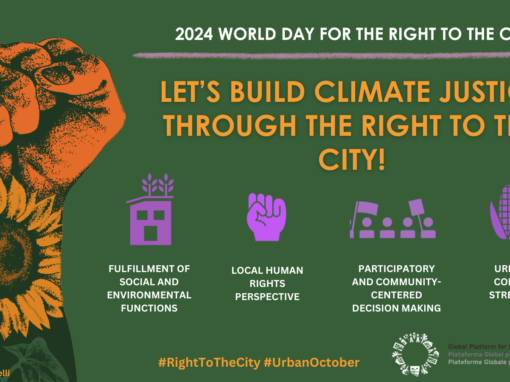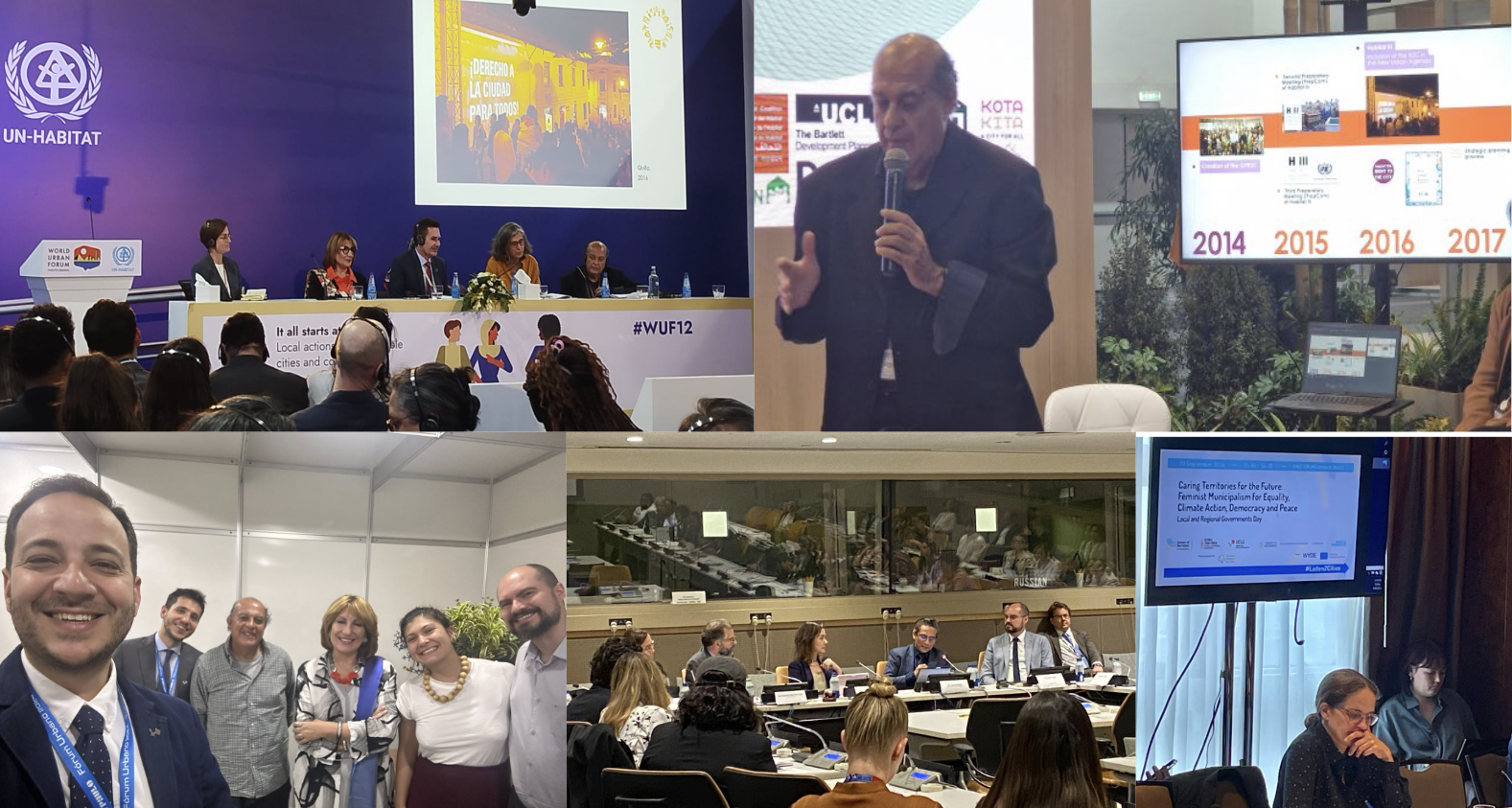We, social movements, civil society and local governments’ organizations are committed to social justice through the promotion, defense and fulfillment of all human rights related to habitat, including the Human Right to Adequate Housing, Land and the Right to the City in every region of the world.
On 1 October 2018, the day designated by the United Nations as World Habitat Day, we reflected on the state of our human settlements and on the human rights related to habitat. World Habitat Day aimed “to remind the world that we all have the power and the responsibility to shape the future of our cities and towns,” but also our future in the wider human habitat.
On 31 October, we celebrated the World Day for the Right to the City, reinterpreting United Nations designation of World Cities Day. We understand the Right to the City as the right of all inhabitants, present and future, permanent and temporary, to inhabit, use, occupy, produce, transform, govern and enjoy cities, towns and human settlements that are just, inclusive, safe, sustainable and democratic, defined as common goods for enjoying life with dignity and peace.
On 10 December, we celebrate Human Rights Day and take the opportunity to denounce Human Rights violations and strengthen the connection between Habitat Rights, the Right to the City and Human Rights Cities.
Background
At Paris, 70 years ago today, UN Member states affirmed that “All human beings are born free and equal in dignity and rights.” Later, in 1966, the United Nations General Assembly adopted two international treaties that would forever ground the development of international human rights: The International Covenant on Economic, Social and Cultural Rights (ICESCR) and the International Covenant on Civil and Political Rights (ICCPR). These two Covenants, along with the Universal Declaration of Human Rights, formed the International Bill of Human Rights, constituting the birth right of all human beings.
In 1996, states supported the Habitat Agenda, that promised a “cross-sectoral approach to human settlements planning, which places emphasis on rural/urban linkages and treats villages and cities as two [points on] a human settlements continuum in a common ecosystem”[i]. Governments then pledged to “intensify our efforts to eradicate poverty and discrimination, to promote and protect all human rights and fundamental freedoms for all, and to provide for basic needs, such as education, nutrition and life-span health care services, and, especially, adequate shelter for all.”[ii]
Since then, other approaches have contextualized human rights and corresponding obligations of states, through all spheres of government, adding the spatial-justice dimension to already-codified human rights.
This is the case of 1998’s European Charter for the Safeguarding of Human Rights in the City stated (Article 1) “The city is a collective space belonging to all who live in it. These have the right to conditions which allow their own political, social and ecological development but at the same time accepting a commitment to solidarity.”
Along the same lines, the 2011 Global Charter for Human Rights in the City affirmed that “All city inhabitants have the right to a city constituted as a local political community that ensures adequate living conditions for all the people, and provides good coexistence among all its inhabitants, and between them and the local authority.”
In the 2011 Gwangju Declaration on Human Right City, Human Right cities are defined as “both a local community and a socio-political process in a local context where Human Rights play a key role as fundamental values and guiding principles.” “Human Rights City also means, in practical terms, that all inhabitants, regardless of race, sex, color, nationality, ethnic background and social status, and in particular minorities and any other vulnerable groups who are socially vulnerable and marginalized, can participate fully in decision-making and policy-implementation processes that affect their lives in accordance with such Human Rights principles as non-discrimination, rule of law, participation, empowerment, transparency and accountability.”
This definition of Human Rights Cities speaks directly to four of the eight Right to the City components, namely a city/human settlement free of discrimination, of gender equality, of inclusive citizenship and with enhanced political participation.
As a collective right, the Right to the City contributes to the integration and contextualization of all civil, political, economic, social, cultural, and environmental rights, as enshrined in existing international Human Rights treaties and instruments.
Giving effect to the Right to the City requires the respect, protection and fulfillment of all Human Rights, without exception, together with the specific principles and entitlements that the Right to the City envisions: the social functions of land, property and the city; the fight against socio-spatial discrimination; high quality public spaces; and sustainable and inclusive rural-urban linkages[iii]. In this sense, the Right to the City perspective seeks to operationalize Human Rights in their human habitat context.
Contemporary challenges
People and communities across the world are vulnerable to human rights habitat violations, often taking the form of forced evictions, denied access to natural resources, land seizure, or the non-recognition of the human right to adequate housing, healthcare, decent work, energy, or public participation, among others. Ideological and religious persecution and the marginalization of women, indigenous populations and minorities are also among the most common violations, which are rising in many regions of the World.
Already at the 1976 Habitat Conference, Vancouver Action Plan warned that “The ideologies of States are reflected in their human settlement policies. These being powerful instruments for change, they must not be used to dispossess people from their land or entrench privilege and exploitation”[iv]. Nonetheless, contemporary forms of discrimination have coupled with historical trends that lead to violations of housing and land rights: These are found in exclusive development paradigms; denial of secure tenure; lack of legal recognition of collective rights to land and other natural resources; declining public-housing assistance; discriminatory access to credit; privatization of basic services; and predatory mortgage loans, among others. A dominant “privatization ethic” increasingly subjects access to adequate housing and land to income competition, leading to new forms of discrimination. This is unacceptable, particularly given the obligations of states and cities to respect, protect and fulfill the human right to adequate housing and land. It is ever more urgent to apply human rights methods of governance in managing urbanization and migration, in particular, as more and more people find refuge in cities, fleeing from war, occupation, rural impoverishment, famine and disaster.
In the face of current trends in human rights violation across the world, we launch this urgent appeal to the United Nations, all states and their governments, international, regional, national and local institutions, civil society organizations and inhabitants to implement the preventive and corrective human rights approach and to embrace the Right to the City in a Human Rights Habitat as a common framework upholding the global policy commitments to address the challenges of our time with equality in rights for women and men, and to achieve social progress and better standards of life in larger freedom for all.
______________________________________________________________________
[i] Istanbul Declaration on Human Settlements and The Habitat Agenda, paras. 104, A/CONF.165/14, 14 June 1996, at: http://undocs.org/en/A/CONF.165/14.
[ii] Istanbul Declaration on Human Settlements, op. cit., Article 7.
[iii] Rural-urban linkages must be understood as a process of a Habitat Metabolism, a vision that addresses and treats human settlements and territories as a living organism, seeking to sustain them.
[iv] The Vancouver Action Plan, A/CONF.70/15, 11 June 1976, Preamble, para. 3, at: http://www.hlrn.org/img/documents/The_Vancouver_Declaration_19761.pdf.






